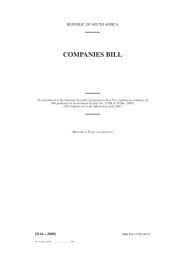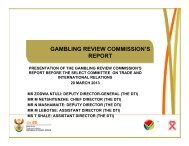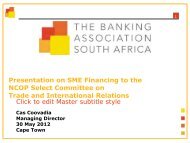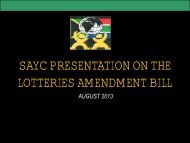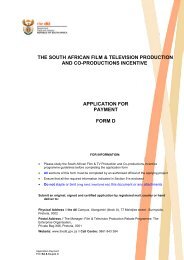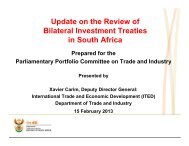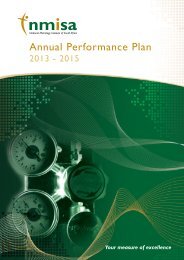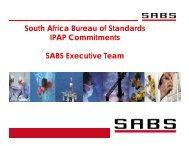Copyright Review Commission Report - ICT Law and Regulation ...
Copyright Review Commission Report - ICT Law and Regulation ...
Copyright Review Commission Report - ICT Law and Regulation ...
- No tags were found...
Create successful ePaper yourself
Turn your PDF publications into a flip-book with our unique Google optimized e-Paper software.
The WCT <strong>and</strong> WPPT oblige members to adopt legislation to prohibit users from removing or deactivating datathat is necessary for the management of copyright, i.e. collection <strong>and</strong> distribution of royalties.4.2.8. A new right of communication to the public was created in Article 8 of the WCT. <strong>Copyright</strong> owners obtained anadditional <strong>and</strong> new exclusive right, namely the right to communicate a work to the public interactively <strong>and</strong> ondem<strong>and</strong> at a time <strong>and</strong> place chosen by the user. The uploading of a work to a server <strong>and</strong> the streaming ofmusic works on the Internet will fall under the communication of the work. This new right has been adopted inthe copyright laws of most other jurisdictions.4.2.9. A new right of ‘making available’ was created in Articles 10 <strong>and</strong> 14 of the WPPT, under which performers <strong>and</strong>producers of phonograms respectively enjoy the exclusive right to authorise the ‘making available’ to the publictheir performances <strong>and</strong> phonograms by wire or wireless means in such a way that members of the public mayaccess them from a place <strong>and</strong> time individually chosen by them.4.2.9. Although South Africa was one of the signatories of the WCT <strong>and</strong> WPPT <strong>and</strong> the treaties have been in force foralmost a decade, an overall impact study has not been completed, <strong>and</strong> the country has not ratified them (thisstudy should be completed as soon as possible). Furthermore, the <strong>Copyright</strong> Act <strong>and</strong> Performers’ Protection Acthave not been amended to grant copyright owners <strong>and</strong> performers the right to control the communication oftheir works on networks. The <strong>Copyright</strong> Act grants the copyright owner of music, literary work <strong>and</strong> soundrecording the exclusive right to distribute his or her work by broadcasting <strong>and</strong> transmitting it in a diffusionservice. The copyright owners of sound recording <strong>and</strong> the performers have the additional right to communicatethe sound recording or fixed performance to the public.4.2.10. Broadcasts <strong>and</strong> programme-carrying signals are technologically specific. Section 1 of the <strong>Copyright</strong> Act definesa broadcast as:a telecommunication service of transmissions consisting of sounds, images, signs or signals which (a) takes place bymeans of electro-magnetic waves of frequencies of lower than 3 000 GHz transmitted in space without an artificialconductor; <strong>and</strong> (b) is intended for reception by the public or sections of the public, <strong>and</strong> includes the emitting ofprogramme-carrying signals to a satellite.A programme-carrying signal is defined as ‘a signal embodying a programme which is emitted <strong>and</strong> passesthrough a satellite’. During the ‘up-leg’ of a transmission, a programme-carrying signal is a broadcast. Once thebroadcast passes through a satellite, it is transformed from a broadcast to a programme-carrying signal. Mobilecommunication protocols, combinations of wired <strong>and</strong> wireless communication systems <strong>and</strong> convergedcommunication platforms fall outside their realm. Webcasting <strong>and</strong> interactive on-dem<strong>and</strong> systems cannot becharacterised as relying on either broadcasts or programme-carrying signals.4.2.11. A diffusion service is defined in Section 1 of the <strong>Copyright</strong> Act as “a telecommunication service of transmissionsconsisting of sounds, images, signs or signals, which takes place over wires or other paths provided by materialsubstance <strong>and</strong> intended for reception by specific members of the public”. One may thus argue that thestreaming of a work to mobile subscribers could amount to the ‘making available’ of a work in a diffusion serviceif wireless communication could by analogy be extended to other paths provided by material substances. Atbest, the definition of a diffusion service should be amended by the inclusion of wireless transmissions.- 30 -





